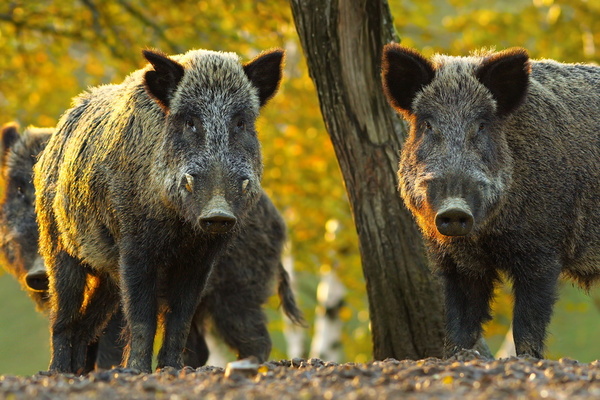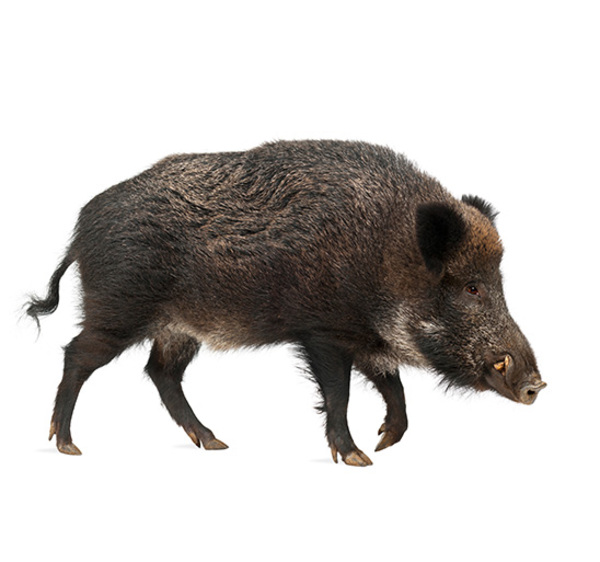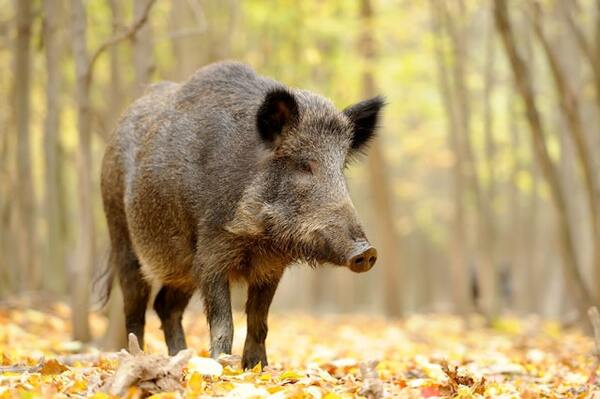Wild pigs are fascinating creatures that can be found in various parts of the world. Among them, some species stand out due to their impressive size. In this article, we will explore the biggest wild pigs, their characteristics, habitats, behaviors, and the role they play in their ecosystems.

Wild pigs, also known as feral pigs, boars, or wild swine, belong to the species Sus scrofa. They are descendants of domesticated pigs and can thrive in diverse environments. Wild pigs are known for their adaptability, intelligence, and strong social structures.
Physical Appearance: Wild pigs have stout bodies, short legs, and a snout that is well adapted for foraging. They usually have coarse hair, which can range from brown to black or even white, depending on the species and habitat.
Size: The size of wild pigs can vary significantly. The largest wild pig species, such as the Eurasian wild boar and the wild pig of the Americas, can weigh up to 600 pounds (272 kg) or more.
Size: Adult males can weigh between 300 and 600 pounds (136 to 272 kg) and can reach a length of 5 to 6.5 feet (1.5 to 2 meters).
Habitat: These boars are found across Europe, Asia, and North Africa. They prefer forests, grasslands, and wetlands, where they can find plenty of food.
Behavior: Eurasian wild boars are social animals, often found in groups called sounders, which consist of females and their young. Males are more solitary, especially outside the breeding season.
Size: Similar to the Eurasian wild boar, males can weigh around 400 to 600 pounds (181 to 272 kg).
Habitat: Wild pigs in the Americas are often found in forested areas, swamps, and agricultural lands. They are widespread, particularly in the southeastern United States.
Behavior: These pigs are opportunistic feeders, consuming a wide variety of food, including roots, fruits, and small animals. They are known for their destructive feeding habits, which can lead to significant ecological damage.
Size: Some subspecies of wild boar, such as the giant wild boar found in specific regions, can exceed 600 pounds (272 kg).
Habitat: These boars are usually located in remote areas with abundant food sources, such as dense forests and wetlands.
Behavior: Like their relatives, giant wild boars are omnivorous and very adaptable, often leading to conflicts with human agriculture.
Wild pigs play a vital role in their ecosystems. As omnivores, they help control vegetation growth and disperse seeds through their foraging activities. However, their impact can be both positive and negative:
Seed Dispersal: By consuming fruits and seeds, wild pigs help in the dispersal of various plant species, promoting biodiversity.
Soil Aeration: Their rooting behavior can aerate the soil, benefiting the overall health of the ecosystem.
Destruction of Vegetation: Wild pigs can cause significant damage to crops and native plants by rooting around for food.
Competition with Native Species: They compete with native wildlife for resources, which can lead to declines in local animal populations.
The biggest wild pigs, such as the Eurasian wild boar and the wild pig of the Americas, are remarkable animals that play important roles in their ecosystems. While they can cause challenges for farmers and native wildlife, understanding their behaviors and characteristics helps us appreciate their place in nature. As humans continue to interact with these animals, it’s crucial to find balanced solutions that allow for coexistence while protecting our agricultural interests and the environment.

Wild pigs, often referred to as feral pigs or wild boars, have become a significant nuisance in many parts of the world. While these animals are fascinating and play important ecological roles, their increasing populations and behaviors can lead to various problems for both agriculture and natural ecosystems. Here’s an in-depth look at the nuisance caused by wild pigs, including the reasons for their proliferation, the problems they create, and potential solutions to mitigate their impact.
Adaptability:
Wild pigs are highly adaptable animals that can thrive in various environments, including forests, grasslands, swamps, and agricultural areas. Their ability to survive in diverse habitats contributes to their growing populations.
High Reproductive Rates:
Wild pigs reproduce quickly, with females capable of having multiple litters each year. A single sow can give birth to 6-12 piglets per litter, leading to rapid population growth.
Lack of Natural Predators:
In many areas, wild pigs face few natural predators, allowing their populations to expand unchecked. This is especially true in regions where they have been introduced and are not part of the local food chain.
Human Activities:
Human activities, such as agricultural practices and habitat modification, can unintentionally create favorable conditions for wild pigs. For example, crops and livestock can provide easy food sources, encouraging pigs to inhabit nearby areas.
Agricultural Damage:
One of the most significant nuisances caused by wild pigs is their impact on agriculture. They can root through fields, damaging crops and causing substantial economic losses for farmers. Commonly affected crops include corn, soybeans, and various fruits and vegetables.
Ecosystem Disruption:
Wild pigs can significantly alter ecosystems. Their rooting behavior can destroy native vegetation, disturb soil structure, and disrupt habitats for other wildlife. This can lead to declines in native plant species and impact overall biodiversity.
Competition with Native Species:
Wild pigs often compete with native wildlife for food and resources. Their presence can lead to declines in populations of native species, particularly ground-nesting birds and small mammals that share similar food sources.
Public Safety Concerns:
Wild pigs can pose safety risks to humans. Encounters with large animals can lead to injuries, particularly in rural areas where people may be more likely to come into contact with them. Additionally, they can cause accidents on roadways, particularly in areas where they cross roads.
Disease Transmission:
Wild pigs can carry and transmit diseases that may affect livestock and even humans. Diseases such as swine brucellosis and pseudorabies are of particular concern and can have serious implications for agricultural operations.
Fencing:
Installing robust fencing around agricultural fields can help prevent wild pigs from accessing crops. While this solution can be effective, it may require significant investment and maintenance.
Trapping and Removal:
Trapping is a humane way to manage wild pig populations. Using baited traps can help capture individuals for removal. It’s essential to follow local regulations and guidelines when implementing trapping programs.
Hunting:
Regulated hunting can help control wild pig populations. Many states and regions encourage hunting as a management strategy, often allowing for hunting during specific seasons or year-round.
Public Education:
Educating the public about the issues related to wild pigs and how to manage their presence can be beneficial. Encouraging responsible practices, such as not feeding wild pigs and reporting sightings, can help mitigate problems.
Research and Monitoring:
Ongoing research to monitor wild pig populations and their impact on ecosystems is crucial. Understanding their behaviors, habitats, and interactions with other species can inform effective management strategies.
While wild pigs can be intriguing animals that contribute to their ecosystems, they also pose significant challenges as nuisances in agricultural and natural environments. Addressing these challenges requires a combination of management strategies, community involvement, and ongoing research to find effective solutions. By balancing the ecological roles of wild pigs with the needs of human populations, it is possible to reduce their negative impacts and promote coexistence.
Wild boars, known scientifically as Sus scrofa, are powerful and adaptable animals found in various parts of the world. While they can be fascinating creatures, their behavior and physical characteristics can pose significant dangers to humans and other animals. This article explores the dangers associated with wild boars, their behavior, and what you need to know to stay safe.
Size and Strength:
Adult wild boars can weigh anywhere from 100 to over 600 pounds (45 to 272 kg) and can measure up to 6.5 feet (2 meters) in length. Their large size and muscular build make them formidable animals.
Tusks:
Wild boars have long, sharp tusks that can be used for defense. These tusks can inflict serious injuries, making them dangerous when the animal feels threatened.
Speed and Agility:
Despite their bulk, wild boars are surprisingly fast and agile. They can run at speeds of up to 30 miles per hour (48 km/h), which allows them to escape danger or confront threats quickly.
Defensive Nature:
Wild boars are generally shy and will avoid human contact when possible. However, if they feel cornered or threatened, they can become aggressive. Mothers with piglets are particularly protective and may attack if they perceive a threat to their young.
Surprising Aggression:
While wild boars usually prefer to flee rather than fight, they can be unpredictable. Sudden movements or loud noises may provoke an aggressive response.
Habitat Encroachment:
As wild boars increasingly inhabit areas close to human populations, encounters are becoming more common. This overlap can lead to dangerous situations, especially in rural and suburban areas where people may not expect to see wild boars.
Disease Transmission:
Wild boars can carry various diseases that pose risks to humans and livestock. These include brucellosis, pseudorabies, and swine flu. Contact with wild boars or their feces can increase the risk of disease transmission.
Avoiding Encounters:
If you live in an area where wild boars are known to roam, it’s essential to be cautious. Avoid walking alone in remote areas, especially at dawn or dusk when boars are more active.
Securing Garbage and Food Sources:
Wild boars are attracted to food, so securing garbage cans and not leaving pet food outside can help deter them from approaching residential areas.
Educating the Public:
Awareness of wild boar behavior and the potential dangers can help people take appropriate precautions. Education about what to do in an encounter can also be beneficial.
Report Sightings:
If you see wild boars in your area, report sightings to local wildlife authorities. They can provide guidance and may take measures to manage the population.
Stay Calm: If you encounter a wild boar, remain calm and avoid sudden movements.
Back Away Slowly: If the boar seems aggressive or is approaching, back away slowly without turning your back on the animal.
Do Not Corner the Animal: If the boar is with piglets or appears defensive, do not approach. Leave the area slowly to avoid provoking an attack.
Seek Shelter: If possible, seek shelter in a vehicle or building until the boar leaves the area.
While wild boars can be dangerous under certain circumstances, understanding their behavior and taking preventive measures can significantly reduce the risk of dangerous encounters. By being aware of their presence and acting responsibly, people can coexist with these powerful animals while minimizing potential dangers.

Wild boars are fascinating creatures that vary in size, appearance, and habitat. Below is a table that ranks different types of wild boars based on their size, along with some key characteristics.
| Rank | Common Name | Scientific Name | Average Weight (lbs) | Average Length (ft) | Habitat | Distribution |
|---|---|---|---|---|---|---|
| 1 | Eurasian Wild Boar | Sus scrofa scrofa | 150-800 | 5-6 | Forests, grasslands, wetlands | Europe, Asia, North Africa |
| 2 | Indonesian Wild Boar | Sus scrofa vittatus | 150-400 | 4-5 | Forests, scrublands | Southeast Asia |
| 3 | Domestic Pig | Sus scrofa domesticus | 100-700 | 3-5 | Farms, grasslands | Worldwide |
| 4 | Bornean Wild Boar | Sus scrofa celebensis | 150-350 | 4-5 | Tropical forests | Borneo |
| 5 | Javan Wild Boar | Sus scrofa montanus | 100-300 | 3-4 | Forests, mountainous regions | Java, Indonesia |
| 6 | Somali Wild Boar | Sus scrofa africanus | 150-400 | 4-5 | Savannas, woodlands | Horn of Africa |
| 7 | Indian Wild Boar | Sus scrofa cristatus | 150-400 | 4-5 | Forests, grasslands | India, Southeast Asia |
| 8 | Pacific Island Wild Boar | Sus scrofa | 100-300 | 3-4 | Various | Pacific Islands |
Eurasian Wild Boar: The largest and most widespread species, known for its adaptability to different habitats.
Indonesian Wild Boar: Typically found in the dense forests of Indonesia, it has a more slender build compared to the Eurasian variety.
Domestic Pig: Descended from wild boars, domestic pigs are bred for various agricultural purposes and exhibit a wide range of sizes and shapes.
Bornean Wild Boar: This species is adapted to tropical rainforests and has distinct physical features, including a more elongated body.
Javan Wild Boar: Found in Java's mountainous regions, it has a smaller stature and a unique coloration.
Somali Wild Boar: Adapted to arid environments, it exhibits a robust build and is often found in savannas.
Indian Wild Boar: Common in various habitats across India, it plays a vital role in local ecosystems.
Pacific Island Wild Boar: Smaller in size, this species is often found on remote islands and has adapted to island life.
Wild boars are diverse animals with various species adapted to different environments. Understanding their characteristics and habitats can help in managing and conserving these remarkable creatures.
animal tags: Wild-boars
We created this article in conjunction with AI technology, then made sure it was fact-checked and edited by a Animals Top editor.